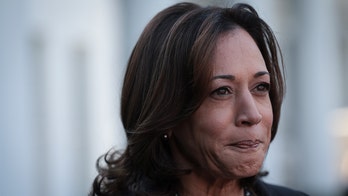
Wednesday: Supreme Court nominee Elana Kagan sits with Senate Majority Leader Harry Reid in the first of several courtesy calls to lawmakers ahead of her confirmation hearing (AP).
While serving as an associate counsel to President Clinton, Elena Kagan expressed concern about a plan to use the Supreme Court to demonstrate the president's commitment to racial diversity, declassified documents show.
The documents, obtained by Fox News from the Clinton Presidential Library in Little Rock. Ark., offer some revealing glimpses into the thinking and bureaucratic style of Kagan, whom President Obama on Monday nominated to the Supreme Court to fill the vacancy created by the retirement of Justice John Paul Stevens.
Some 300 documents associated with Kagan's service from 1995 to 1999 as associate White House counsel and deputy director of the Domestic Policy Council were obtained by Fox News researchers.
But much of Kagan's official file from that period remains sealed. That may change as the Senate Judiciary Committee prepares for Kagan's confirmation hearing later this summer, and committee staffers press for expanded access to the documents Kagan generated during the Clinton era.
As a top lawyer and domestic policy aide in the Clinton White House, Kagan worked on a broad range of policy issues: immigration reform, health care, tobacco regulation, Native American affairs. Another subject in which she played a central role was the development of Clinton's initiative on race relations.
Presented with an unsigned "draft work plan" for the initiative, dated Sept. 4, 1997 -- more than three months after the effort was publicly unveiled -- Kagan was struck by one proposal in particular.
An elaborate chart detailing "sub-strategies and tasks" to help execute an overall strategy to "develop a communications/media plan" included the proposal that the administration "recognize and promote minority achievement in non-traditional areas."
The draft plan further suggested that such areas ripe for the White House's PR exploitation should include "Supreme Court justices, astronauts, federal, city, and state leaders." Kagan circled the words "Supreme Court justices," scrawled an exclamation mark next to it, and forwarded the document to her boss, White House domestic policy adviser Bruce Reed, with a pithy note saying: "FYI."
Another set of documents detailed Kagan's work in helping to shape the manuscript for a book on race relations that was to be published under President Clinton's name. Kagan advised against the inclusion of a drafted passage that would have suggested that racism was often the motivation for urban police stopping and searching "persons of color."
The manuscript stated that such encounters involve a "disproportionate" number of minorities and that "there are just too many examples, some horrific, to ignore the problem." Presented with these statements in a March 26, 1999, memorandum, Kagan wrote in the margin: "I don't know what this refers to, but I wonder whether we want to be arguing here."
In this task, Kagan was relying on her old skills as an editor at the Daily Princetonian, the student newspaper at Princeton University where she had once applied the red pencil to columns authored by Reed, who was one year her junior.
Proposed criticisms of the manuscript for the Clinton book on race relations apparently struck Kagan as too harsh in tone. The March 26, 1999, memo was drafted for her and Reed's signature by an unnamed aide, and addressed to White House Staff Secretary Todd Stern.
"With all due respect to the time and talent that have already gone into this project," the memo stated, "the current draft is a passable government report, not a bold vision of race and America for the 21st century."
Beside this sentence, Kagan scrawled: "maybe too much." The next sentence in the draft memo stated: "We doubt that this is the caliber of the book the president was hoping for or expecting."
Beside that, Kagan scribbled: "definitely too much." She also deleted sentences in the memo that accused the draft manuscript of being "hopelessly trite" and "devoid of depth, complexity, or emotion."
Like many capable bureaucrats, Kagan keenly guarded her turf. When another White House aide working on a modernization program for American cities argued that an "implicit goal" for the program should be to "promote racial healing,"
Kagan wrote to Reed: "Katie is now trying to make this a part of the race initiative! (see last bullit [sic])."
Kagan also expressed displeasure when she came to believe that Maria Echaveste, then head of the White House Office of Public Liaison (OPL), failed to give proper credit to Kagan's staff for its work on a document the two offices had jointly prepared.
"Bruce," she wrote to Reed atop a March 4, 1997, document about an upcoming civil rights event, "Have you seen this?...Take a look at the briefing materials. Some were prepared by (a Kagan aide) in response to a request from OPL."
In the final product, Kagan continued, Echaveste had "omitted all references that made it clear that the materials were from this office. At the very least," Kagan snapped, "our response to this should be to call Maria and tell her that when next she wants help from our staff in preparing briefing materials, she should check in with one of us first."
Kagan served as one of the Clinton administration's key negotiators in some tussles with Congress on issues like immigration, campaign finance reform and tobacco regulation. Although the paper trail documenting Kagan's relations with lawmakers is not fully fleshed out, the available documents offer some glimpse into her approach to this work.
If confirmed to sit on the Supreme Court, Kagan would be called upon to conduct similar discussions with her fellow justices: seeking to persuade them to sign on to her opinions, to drop their opposition to key passages, and so on.
When the Clinton administration was embroiled in a dispute with Congress over a bill that would limit the number of Latin American immigrants who could remain in the country, Kagan endorsed a plan for the White House to present its own bill "and privately refer to the possibility of (executive action) as a form of leverage."
Elsewhere, in a March 19, 1998, memo to the president sent by Reed and Kagan on the subject of reforming the Immigration and Naturalization service, she wrote: "We have met with key Hill staff to try to get a sense of where the Congress is going on the INS reform issue, and how it would respond to our proposal. ... Most members of Congress are approaching the issue cautiously ... Rep. Lamar Smith (R-Texas), who will be critical to the outcome, is playing his cards very close to the vest."
Eleven days later, Kagan and another aide, Sally Katzen, sent a memo to members of the Domestic Policy Council addressing pending Senate legislation on H-1B visa issues, which was then of paramount concern to the information technology industry.
Kagan and Katzen warned their colleagues that the industry might either "be willing to cut a deal with (Senator Edward) Kennedy if the (Senator Spencer) Abraham bill stalls," and, conversely, that the industry may "not deal with Kennedy, even if that risks a veto."
The documents also reveal a chummy, largely co-equal relationship between Kagan and Reed. When an undated draft of an "action memorandum" to the president about Central American migrants was first circulated to those aides who would be listed as the memo's authors -- a group that included Reed, National Security Adviser Sandy Berger, and three others -- it first passed through the hands of Kagan, who forwarded it along to her boss with the annotation: "Bruce -- I took the liberty of approving this memo for you. I believe it went into the president on Friday. Elena."
Another document -- a dense review of pending legislative and administrative action on immigration reform, dated July 2, 1997 -- Kagan sent to Reed with her handwritten advice: "Lots of legal gobbledygook; don't spend too much time on it. Instead, read the memo signed by you! (and others). Elena."
The documents also reveal the future Supreme Court nominee's occasionally sarcastic sense of humor. On February 9, 1999, aides from an inter-agency group circulated an agenda for a meeting on the subject of civil rights enforcement.
The document included five agenda items -- "Introductions," "Meeting Purpose," "Strategy Goals and Objectives," "Operational Structure," and "Questions and Answers") -- and left the spaces beneath all five entirely blank, with no other substance to the document.
"Bruce," scrawled Kagan, "Sure glad they sent this around. E."
"Fox News' Jessica Stone and Lee Ross contributed to this report from Washington, D.C., and Kimbery Wessels contributed from the Clinton presidential library in Little Rock."




